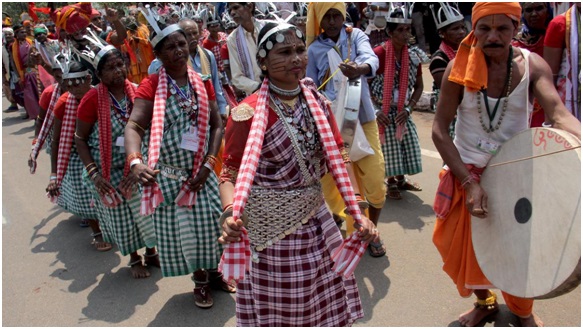Preserving tribal culture: Odisha’s Special Development Councils model is worth emulating (The Hindu)

- 02 Aug 2023
Why in the News?
In Odisha's development model driven by the 5T principles (transparency, technology, teamwork, time limit, and transformation), the vision of inclusive growth and community-led development goes beyond being a mere idea; it stands as an actionable strategy with tangible outcomes.
Tribal population in India:
- India encompasses a significant tribal population of 8.6%, possessing a vast repository of indigenous knowledge that holds the potential to offer sustainable solutions through recognition, adoption, and integration into mainstream practices.
- As per Article 342 of the Indian Constitution, the President has the authority to specify, with respect to any State or Union territory, the tribes, tribal communities, parts of, or groups within tribes or tribal communities as Scheduled Tribes.
Tribal Culture: A Glimpse
- Communal Bond: Many tribal communities in India embrace a strong sense of communal living, where resources are shared, and decisions are collectively made within close-knit communities.
- Connection with Nature: Tribals deeply connect with nature, embracing traditional beliefs and practices centered around forests and animals.
- Self-Sufficiency: A tribe embodies self-reliance, forming relatively closed societies where their self-sufficiency pursuits define their openness to the outside world.
- Spiritual Traditions: Tribals nurture distinct spiritual beliefs, often venerating ancestors, nature spirits, or deities, adding uniqueness to their cultural tapestry.
- Expressive Artistry: Tribals are celebrated for their exquisite art forms, such as pottery, weaving, and jewelry making. These crafts hold spiritual and cultural significance, passing down through generations.
Tribal Lifestyle and Sustainable Development:
- Harmony with Nature: The tribal lifestyle upholds profound respect for the natural environment, incorporating sustainable practices like using natural materials for housing, food, and medicine, and living in sync with nature's cycles.
- Community-Centric Decision-Making: Their collective decision-making process prioritizes the needs of the entire community, ensuring sustainable and equitable choices.
- Biodiversity Preservation: Tribals actively promote biodiversity by employing traditional agricultural techniques like intercropping and seed saving, as well as safeguarding sacred sites vital for biodiversity conservation.
- Resource Conservation: Sustainable practices involve judicious resource usage, such as rotational farming and allowing forests to regenerate before harvesting timber, ensuring their long-term availability.
- Intergenerational Knowledge Transfer: Passing down knowledge to future generations includes traditional wisdom about the natural environment and sustainable resource management.
- Water Resource Protection: Tribal communities have devised practices to safeguard water resources, guaranteeing their availability for future generations while reducing greenhouse gas emissions.
- Regenerative Agriculture: For centuries, tribal communities have practiced regenerative agriculture, incorporating crop rotation, intercropping, and organic matter to enrich soils and sequester carbon, contributing to climate change mitigation.
- Embracing Renewable Energy: Traditional reliance on renewable energy sources like wind, solar, and hydropower offers a model for expanding and modernizing clean energy solutions for broader communities.
Challenges Confronting Tribal Lifestyles:
- Discrimination: Tribal communities frequently encounter discrimination and bias from the dominant society, leading to restricted access to education, healthcare, and essential services.
- Land Rights: Displacement from ancestral lands due to industrialization and mining has led to the loss of cultural identity and socio-economic marginalization among tribal communities.
- Climate Change and Environmental Degradation: Adverse effects of climate change, such as altered rainfall patterns, more frequent natural disasters, biodiversity loss, deforestation, pollution, and habitat destruction, have severely impacted their traditional livelihoods and ways of life.
- Socioeconomic Marginalization: Limited access to education, healthcare, and economic opportunities has resulted in poverty and social exclusion for many tribal communities.
- Lack of Political Representation: Tribal communities often lack political representation, depriving them of a voice in decision-making processes that directly influence their lives.
- Cultural Assimilation: Pressures to conform to the dominant culture impose a risk of losing traditional knowledge, language, and cultural practices within many tribal communities.
What is Odisha's Special Development Councils (SDCs) Initiative?
- In a momentous stride towards preserving, promoting, and celebrating tribal culture while advancing the trajectory of development, the Odisha government introduced the Special Development Councils (SDCs) initiative in 2017.
- The primary objective is to safeguard the rich culture and heritage of 62 tribes in the State under a unified approach while ensuring continued economic progress in the regions.
- Originally encompassing 9 tribal-dominated districts and benefiting 60 lakh tribal households across 117 blocks, the initiative has now expanded to cover 23 districts, extending its benefits to over 84 lakh tribal individuals.
Government Initiatives for Tribal Culture Conservation:
- National Scheduled Tribes Finance and Development Corporation (NSTFDC): Established in 2001 under the Ministry of Tribal Affairs, NSTFDC aims to uplift Scheduled Tribes economically through concessional financial assistance under various schemes.
- TRIFED's Tribal Initiatives: The government plans to establish 50,000 Van Dhan Vikas Kendras and 3,000 Haat Bazaars, fostering economic opportunities for tribal populations.
- Central Sector Scheme: Supporting Institutional Development & Marketing of Tribal Products/Produce.
- Centrally Sponsored Scheme: Ensuring a sustainable mechanism for Marketing Minor Forest Produce (MFP) through Minimum Support Price (MSP) and developing value chains, providing social safety for MFP gatherers.
- Pradhan Mantri Van Dhan Yojana: A market-linked tribal entrepreneurship development program promoting the formation and strengthening of Tribal Producer Companies through clusters of tribal Self Help Groups (SHGs).
- Scholarships: Government-funded scholarships for pre-matric, post-matric, and overseas education, facilitating educational access for tribal students.
- Support to NSTFDC: Assistance to the National Scheduled Tribes Finance and Development Corporation for further empowerment initiatives.
- Development of Particularly Vulnerable Tribal Groups (PVTGs): Comprehensive support encompassing housing, land distribution, agricultural and animal husbandry development, link road construction, and more.
- Vocational Training in Tribal Areas: Focused on enhancing the skills of ST youth for diverse job opportunities and self-employment, elevating their socio-economic status.
Mains Question:
- Examine the challenges faced by tribal lifestyles and evaluate the effectiveness of government initiatives for tribal culture conservation in improving socio-economic conditions and preserving cultural heritage among tribals. (15M)
